

Compact Muon Solenoid
LHC, CERN
| CMS-PAS-EXO-20-008 | ||
| Search for heavy resonances decaying to b quarks in proton-proton collisions at √s= 13 TeV | ||
| CMS Collaboration | ||
| July 2021 | ||
| Abstract: Searches are performed for resonances decaying to two jets, with at least one jet originating from a b quark, in proton-proton collisions at √s= 13 TeV. The dataset corresponds to an integrated luminosity of 137 fb−1 collected by the CMS detector at the LHC. Jets are identified as containing energetic b hadrons using a deep neural network b tagger. The invariant mass spectrum of b-tagged dijets is well described by a smooth parameterization and no evidence for the production of new particles is observed. Cross-section upper limits are set on resonances decaying into b quarks. These limits exclude at 95% confidence level models of Z' bosons with a mass less than 2.4 TeV, and an excited b quark with mass less than 4.0 TeV. | ||
|
Links:
CDS record (PDF) ;
CADI line (restricted) ;
These preliminary results are superseded in this paper, Submitted to PRD. |
||
| Figures | |

png pdf |
Figure 1:
Signal shapes of b* from the process bg → b* → bg. These reconstructed dijet mass spectra show wide jets from the PYTHIA 8 MC event generator including simulation of the CMS detector. |
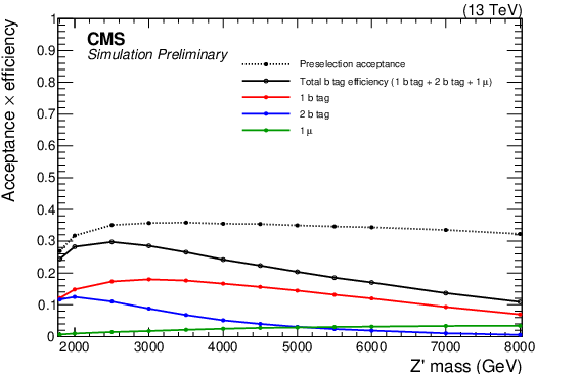
png pdf |
Figure 2:
The acceptance times efficiency of the event selection for a Z′→bˉb resonance as a function of the generated mass. |

png pdf |
Figure 3:
The dijet mass spectra with both jets b tagged (points) are fit with background functional forms (solid curves). The 2016 data is fit with a 3 parameter function (left), 2017 is fit with 4 parameters (middle), and 2018 with 3 parameters (right). The lower panel shows the pull, (data-fit)/uncertainty, in units of the statistical uncertainty. |

png pdf |
Figure 3-a:
The dijet mass spectra with both jets b tagged (points) are fit with background functional forms (solid curves). The 2016 data is fit with a 3 parameter function (left), 2017 is fit with 4 parameters (middle), and 2018 with 3 parameters (right). The lower panel shows the pull, (data-fit)/uncertainty, in units of the statistical uncertainty. |
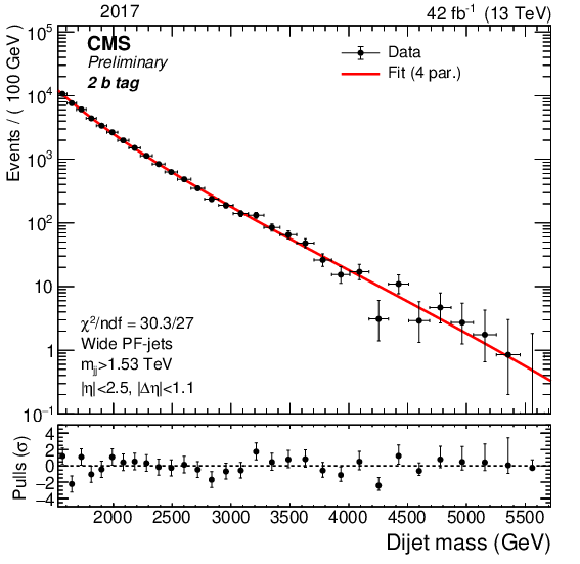
png pdf |
Figure 3-b:
The dijet mass spectra with both jets b tagged (points) are fit with background functional forms (solid curves). The 2016 data is fit with a 3 parameter function (left), 2017 is fit with 4 parameters (middle), and 2018 with 3 parameters (right). The lower panel shows the pull, (data-fit)/uncertainty, in units of the statistical uncertainty. |
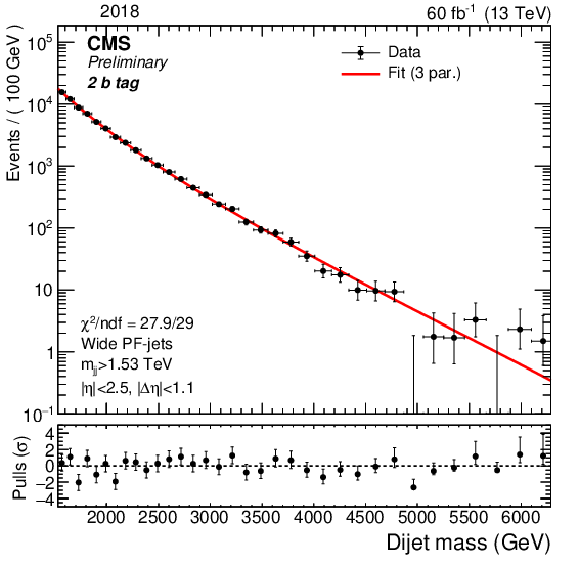
png pdf |
Figure 3-c:
The dijet mass spectra with both jets b tagged (points) are fit with background functional forms (solid curves). The 2016 data is fit with a 3 parameter function (left), 2017 is fit with 4 parameters (middle), and 2018 with 3 parameters (right). The lower panel shows the pull, (data-fit)/uncertainty, in units of the statistical uncertainty. |

png pdf |
Figure 4:
Same as Fig. 3 for the category where only one jet is b tagged. A background functional form with 3 parameters is used to fit the data in 2016 (left), 2017 (middle) and 2018 (right). |
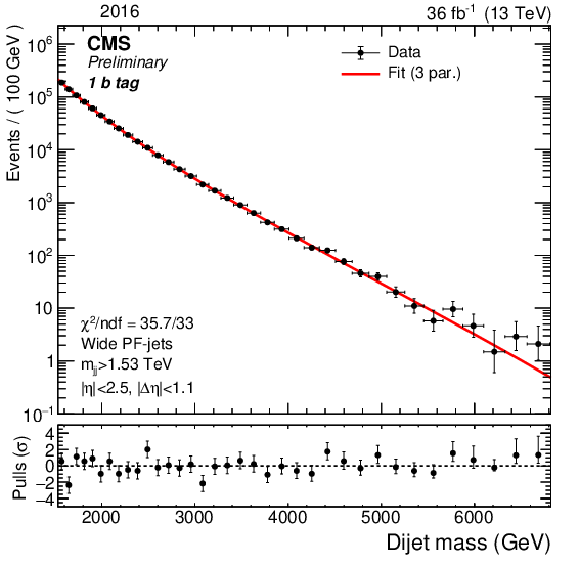
png pdf |
Figure 4-a:
Same as Fig. 3 for the category where only one jet is b tagged. A background functional form with 3 parameters is used to fit the data in 2016 (left), 2017 (middle) and 2018 (right). |
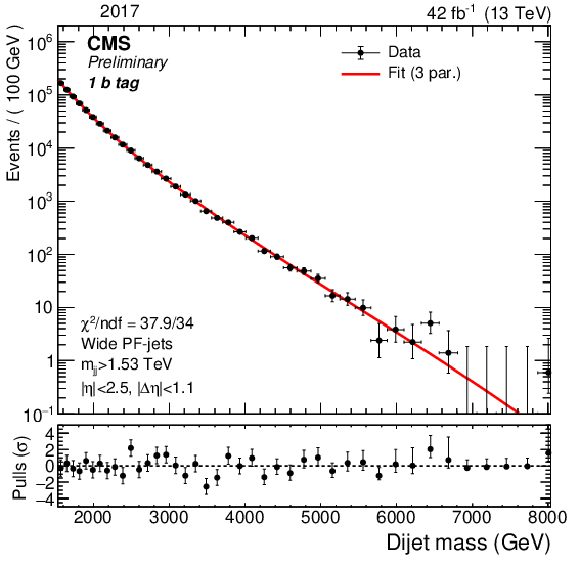
png pdf |
Figure 4-b:
Same as Fig. 3 for the category where only one jet is b tagged. A background functional form with 3 parameters is used to fit the data in 2016 (left), 2017 (middle) and 2018 (right). |

png pdf |
Figure 4-c:
Same as Fig. 3 for the category where only one jet is b tagged. A background functional form with 3 parameters is used to fit the data in 2016 (left), 2017 (middle) and 2018 (right). |

png pdf |
Figure 5:
Same as Fig. 3 for the category where at least one jet contains a muon. The 2016 data is fit with a 4 parameter function (left), 2017 is fit with 3 parameters (middle), and 2018 with 3 parameters (right) |

png pdf |
Figure 5-a:
Same as Fig. 3 for the category where at least one jet contains a muon. The 2016 data is fit with a 4 parameter function (left), 2017 is fit with 3 parameters (middle), and 2018 with 3 parameters (right) |
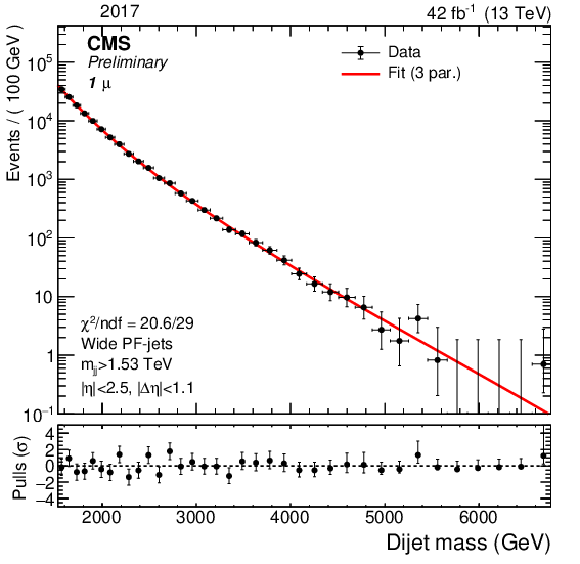
png pdf |
Figure 5-b:
Same as Fig. 3 for the category where at least one jet contains a muon. The 2016 data is fit with a 4 parameter function (left), 2017 is fit with 3 parameters (middle), and 2018 with 3 parameters (right) |
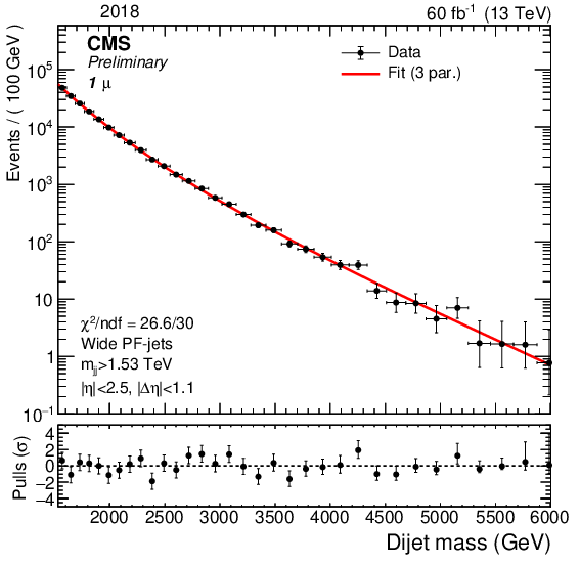
png pdf |
Figure 5-c:
Same as Fig. 3 for the category where at least one jet contains a muon. The 2016 data is fit with a 4 parameter function (left), 2017 is fit with 3 parameters (middle), and 2018 with 3 parameters (right) |

png pdf |
Figure 6:
Same as Fig. 3 for the category where at least one jet is b tagged. The 2016 data is fit with a 5 parameter function (left), 2017 is fit with 5 parameters (middle), and 2018 with 4 parameters (right). |

png pdf |
Figure 6-a:
Same as Fig. 3 for the category where at least one jet is b tagged. The 2016 data is fit with a 5 parameter function (left), 2017 is fit with 5 parameters (middle), and 2018 with 4 parameters (right). |

png pdf |
Figure 6-b:
Same as Fig. 3 for the category where at least one jet is b tagged. The 2016 data is fit with a 5 parameter function (left), 2017 is fit with 5 parameters (middle), and 2018 with 4 parameters (right). |
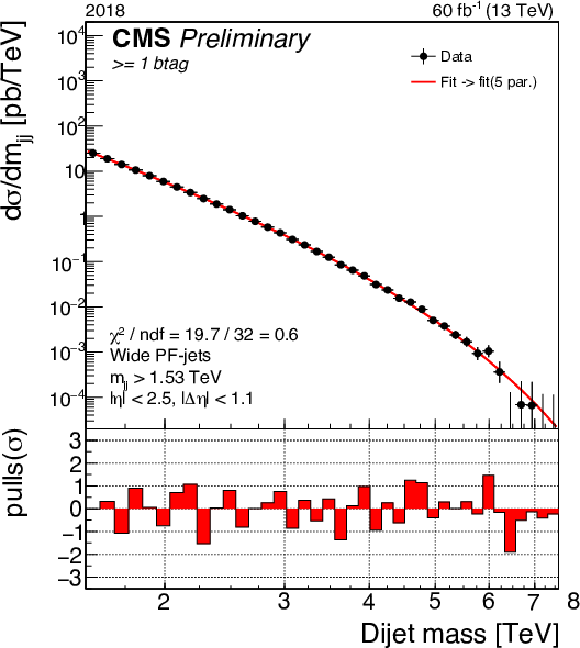
png pdf |
Figure 6-c:
Same as Fig. 3 for the category where at least one jet is b tagged. The 2016 data is fit with a 5 parameter function (left), 2017 is fit with 5 parameters (middle), and 2018 with 4 parameters (right). |

png pdf |
Figure 7:
The observed 95% CL upper limits (solid curve) on the product of the cross section times branching fraction (left), and multiplied by signal acceptance accounting for kinematic requirements (right), for a resonance decaying to bˉb. The corresponding expected limits (dashed curve) and their variations at the 1 and 2 standard deviation levels (shaded bands) are also shown. Limits are compared to predicted cross sections for Z' bosons from the sequential standard model and the heavy vector triplet models A and B. |

png pdf |
Figure 7-a:
The observed 95% CL upper limits (solid curve) on the product of the cross section times branching fraction (left), and multiplied by signal acceptance accounting for kinematic requirements (right), for a resonance decaying to bˉb. The corresponding expected limits (dashed curve) and their variations at the 1 and 2 standard deviation levels (shaded bands) are also shown. Limits are compared to predicted cross sections for Z' bosons from the sequential standard model and the heavy vector triplet models A and B. |
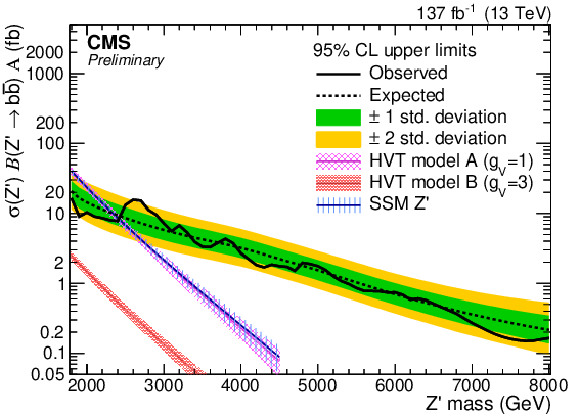
png pdf |
Figure 7-b:
The observed 95% CL upper limits (solid curve) on the product of the cross section times branching fraction (left), and multiplied by signal acceptance accounting for kinematic requirements (right), for a resonance decaying to bˉb. The corresponding expected limits (dashed curve) and their variations at the 1 and 2 standard deviation levels (shaded bands) are also shown. Limits are compared to predicted cross sections for Z' bosons from the sequential standard model and the heavy vector triplet models A and B. |

png pdf |
Figure 8:
The coupling strengths to SM bosons (gH) and fermions (gF) of a Z' boson with mass 2 TeV (red hatched) and 2.5 TeV (blue hatched), which are excluded at 95% CL for the HVT model. The benchmark scenarios corresponding to HVT models A and B are represented by a purple cross and a red point, respectively. The gray shaded area corresponds to the region where the resonance natural width is predicted to be larger than the typical experimental resolution, and thus the narrow-width approximation is not fulfilled. |

png pdf |
Figure 9:
The observed 95% CL upper limits on the product of the cross section, branching fraction, and acceptance for dijet resonances decaying to a b quark and a gluon (points). The corresponding expected limits (short dashed) and their variations at the 1 and 2 standard deviation levels (shaded bands) are also shown. Limits are compared to predicted cross sections for single b* production (dot dashed), the resonant component of ¯bb∗ production (long dashed), and the total b* signal from the sum of these two processes (double dot dashed). |
| Summary |
| A search for heavy resonances decaying into b quarks has been presented. The data sample was collected by the CMS experiment at √s= 13 TeV during 2016, 2017, and 2018 and corresponds to an integrated luminosity of 137 fb−1. Upper limits in the range 0.4-400 fb are set on the product of the cross section of the resonance and the branching fraction to b quarks. Signals of Z' bosons decaying to pairs of b quarks are considered, for both previously explored SSM models, and also for a new heavy vector triplet model. The decays of Z' bosons in both the SSM and the HVT model A are excluded at 95% CL for masses less than 2.4 TeV, and limits are set on the coupling strength of the HVT boson to SM bosons and fermions. Signals of an excited b quark are considered, for both a previously explored channel, bg → b* → bg, and a new channel, qˉq→¯bb∗→¯bbg, and the excited b quark is excluded at 95% CL for masses less than 4.0 TeV. With the inclusion of the ¯bb∗ process, this is the most stringent exclusion of the excited b quark. |
| References | ||||
| 1 | CMS Collaboration | Precise determination of the mass of the Higgs boson and tests of compatibility of its couplings with the standard model predictions using proton collisions at 7 and 8 TeV | EPJC 75 (2015) 212 | CMS-HIG-14-009 1412.8662 |
| 2 | ATLAS Collaboration | Measurement of the Higgs boson mass from the H→γγ and H→ZZ∗→4ℓ channels in pp collisions at center-of-mass energies of 7 and 8~TeV with the ATLAS detector | PRD 90 (2014) 052004 | 1406.3827 |
| 3 | ATLAS Collaboration | Evidence for the spin-0 nature of the Higgs boson using ATLAS data | PLB 726 (2013) 120 | 1307.1432 |
| 4 | ATLAS and CMS Collaboration | Combined measurement of the Higgs boson mass in pp collisions at √s= 7 and 8 TeV with the ATLAS and CMS experiments | PRL 114 (2015) 191803 | 1503.07589 |
| 5 | V. D. Barger, W.-Y. Keung, and E. Ma | A gauge model with light W and Z bosons | PRD 22 (1980) 727 | |
| 6 | E. Salvioni, G. Villadoro, and F. Zwirner | Minimal Z' models: present bounds and early LHC reach | JHEP 09 (2009) 068 | 0909.1320 |
| 7 | P. Langacker | The physics of heavy z' gauge bosons | Rev. Mod. Phys. 81 (2009) 1199 | |
| 8 | D. Pappadopulo, A. Thamm, R. Torre, and A. Wulzer | Heavy vector triplets: bridging theory and data | JHEP 09 (2014) 60 | 1402.4431 |
| 9 | H. Terazawa, M. Yasuè, K. Akama, and M. Hayashi | Observable effects of the possible sub-structure of leptons and quarks | PLB 112 (1982) 387 | |
| 10 | E. Eichten and M. Peskin | New tests for quark and lepton substructure | PRL 50 (1983) 811 | |
| 11 | H. Harari | Composite models for quarks and leptons | Phys. Rep. 104 (1984) 159 | |
| 12 | U. Baur, I. Hinchliffe, and D. Zeppenfeld | Excited Quark Production at Hadron Colliders | Int. J. Mod. Phys. A 2 (1987) 1285 | |
| 13 | U. Baur, M. Spira, and P. M. Zerwas | Excited quark and lepton production at hadron colliders | PRD 42 (1990) 815 | |
| 14 | R. M. Harris and K. Kousouris | Searches for Dijet Resonances at Hadron Colliders | Int. J. Mod. Phys. A 26 (2011) 5005--5055 | 1110.5302 |
| 15 | ATLAS Collaboration | Search for new resonances in mass distributions of jet pairs using 139 fb−1 of pp collisions at √s= 13 TeV with the ATLAS detector | JHEP 03 (2020) 145 | 1910.08447 |
| 16 | CMS Collaboration | Search for high mass dijet resonances with a new background prediction method in proton-proton collisions at √s= 13 TeV | JHEP 05 (2020) 033 | CMS-EXO-19-012 1911.03947 |
| 17 | G. Ciezarek et al. | A Challenge to Lepton Universality in B Meson Decays | Nature 546 (2017) 227 | 1703.01766 |
| 18 | CMS Collaboration | Search for narrow resonances and quantum black holes in inclusive and b-tagged dijet mass spectra from pp collisions at √s= 7 TeV | JHEP 01 (2013) 013 | |
| 19 | CMS Collaboration | Search for resonances and quantum black holes using dijet mass spectra in proton-proton collisions at √s= 8 TeV | PRD 91 (2015) 052009 | |
| 20 | CMS Collaboration | Description and performance of track and primary-vertex reconstruction with the CMS tracker | JINST 9 (2014) P10009 | CMS-TRK-11-001 1405.6569 |
| 21 | CMS Collaboration | The CMS experiment at the CERN LHC | JINST 3 (2008) S08004 | CMS-00-001 |
| 22 | CMS Collaboration | Performance of the CMS Level-1 trigger in proton-proton collisions at √s= 13 TeV | JINST 15 (2020) P10017 | CMS-TRG-17-001 2006.10165 |
| 23 | CMS Collaboration | The CMS trigger system | JINST 12 (2017) P01020 | CMS-TRG-12-001 1609.02366 |
| 24 | J. Alwall et al. | The automated computation of tree-level and next-to-leading order differential cross sections, and their matching to parton shower simulations | JHEP 07 (2014) 079 | 1405.0301 |
| 25 | T. Sjostrand, S. Mrenna, and P. Skands | A brief introduction to PYTHIA 8.1 | CPC 178 (2008) 852 | 0710.3820 |
| 26 | T. Sjostrand, S. Mrenna, and P. Skands | PYTHIA 6.4 physics and manual | JHEP 05 (2006) 026 | hep-ph/0603175 |
| 27 | P. Skands, S. Carrazza, and J. Rojo | Tuning PYTHIA 8.1: the Monash 2013 Tune | EPJC 74 (2014) 3024 | 1404.5630 |
| 28 | CMS Collaboration | Event generator tunes obtained from underlying event and multiparton scattering measurements | EPJC 76 (2016) 155 | CMS-GEN-14-001 1512.00815 |
| 29 | R. D. Ball et al. | Parton distributions with qed corrections | NPB 877 (2013) 290 | |
| 30 | R. D. Ball et al. | Unbiased global determination of parton distributions and their uncertainties at nnlo and at lo | NPB 855 (2012) 153 | |
| 31 | GEANT4 Collaboration | GEANT4---a simulation toolkit | NIMA 506 (2003) 250 | |
| 32 | CMS Collaboration | Particle-flow reconstruction and global event description with the CMS detector | JINST 12 (2017) P10003 | CMS-PRF-14-001 1706.04965 |
| 33 | M. Cacciari, G. P. Salam, and G. Soyez | The anti-kt jet clustering algorithm | JHEP 04 (2008) 063 | 0802.1189 |
| 34 | M. Cacciari, G. P. Salam, and G. Soyez | FastJet user manual | EPJC 72 (2012) 1896 | 1111.6097 |
| 35 | M. Cacciari, G. P. Salam, and G. Soyez | The catchment area of jets | JHEP 04 (2008) 005 | 0802.1188 |
| 36 | CMS Collaboration | Pileup removal algorithms | CMS-PAS-JME-14-001 | CMS-PAS-JME-14-001 |
| 37 | CMS Collaboration | Jet energy scale and resolution in the CMS experiment in pp collisions at 8 TeV | JINST 12 (2017) P02014 | CMS-JME-13-004 1607.03663 |
| 38 | CMS Collaboration | Jet algorithms performance in 13 TeV data | CMS-PAS-JME-16-003 | CMS-PAS-JME-16-003 |
| 39 | Verzetti, Mauro | Machine learning techniques for jet flavour identification at cms | EPJ Web Conf. 214 (2019) 06010 | |
| 40 | CMS Collaboration | Identification of double-b quark jets in boosted event topologies | CMS-PAS-BTV-15-002 | CMS-PAS-BTV-15-002 |
| 41 | CMS Collaboration | CMS luminosity measurement for the 2016 data taking period | CDS | |
| 42 | J. Butterworth et al. | PDF4LHC recommendations for LHC Run II | JPG 43 (2016) 23001 | 1510.03865 |
| 43 | CMS and ATLAS Collaborations | Procedure for the LHC Higgs boson search combination in Summer 2011 | CMS-NOTE-2011-005 | |
| 44 | CMS Collaboration | Combination of CMS searches for heavy resonances decaying to pairs of bosons or leptons | PLB 798 (2019) 134952 | CMS-B2G-18-006 1906.00057 |
| 45 | T. Junk | Confidence level computation for combining searches with small statistics | NIMA 434 (1999) 435 | hep-ex/9902006 |
| 46 | A. L. Read | Presentation of search results: the CLs technique | JPG 28 (2002) 2693 | |
| 47 | G. Cowan, K. Cranmer, E. Gross, and O. Vitells | Asymptotic formulae for likelihood-based tests of new physics | EPJC 71 (2011) 1554 | 1007.1727 |

|
Compact Muon Solenoid LHC, CERN |

|

|

|

|

|

|